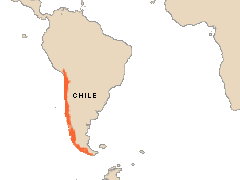
How do we know
To determine whether the observed decrease in prevalence of neural-tube defects in the Chilean population could be attributed to the folic acid fortification program or a pre-existing trend, a group of Brazilian researchers analyzed findings from congenital malformation surveillance studies. Based on a population survey from two prefortification periods (1982–1989 and 1990–2000), the researchers determined that NTD prevalence rates were not decreasing in Chile before the mandate to fortify wheat flour with folic acid. In addition, the rates of decrease after fortification were found to be comparable to decreases in prevalence in other countries with folic acid fortification programs such as Canada and the United States.Downloads
- Read the entire case study
(PDF | 166 K)
External Links
- Conduct additional research on neural tube defects
- Research the global burden of birth defects
- Read about current knowledge and future priorities of folic acid fortification (PDF)
- Read about the effectiveness of fortification with different nutrients
- Learn about other efforts for flour fortification
Health Condition: Each year, neural-tube defects affect more than 300,000 newborns worldwide. Anencephaly and spina bifida, the two most common NTDs, are important contributors to infant and fetal mortality: all infants with anencephaly are stillborn or die shortly after birth and those born with spina bifida suffer life-long disabilities and require extensive medical care. Neural-tube defects (NTDs), the second most common congenital malformation after congenital heart disease, affected about 400 babies in Chile in the years before the fortification intervention. The NTD rate of 17.2 per 10,000 live births had been unchanged from 1967 to 1999.
Intervention or Program: Aware of the effect of folic acid on the prevention of neural tube defects and encouraged by public health experts, the Chilean Ministry of Health introduced new legislation in early 2000 stipulating that all domestically-produced wheat flour must be fortified with folic acid. Flour mills began producing, distributing, and marketing wheat flour in compliance with the new legislation, and the government helped to regulate and monitor the quality of fortified flour.
Cost and Cost-Effectiveness: With existing technologies, the cost of adding folic acid to the pre-mix for fortified flour is approximately 15 cents per ton of wheat flour, making the cost of fortification only 16 cents per woman of reproductive age receiving the target amount of folic acid. With the total cost of rehabilitation for a child affected with spina bifida averaging $100,000, Chile’s health system saved an estimated $11 million (based on 110 cases in one year).
Impact: Shortly after the fortification legislation was passed, 91 percent of wheat bread was being produced with fortified flour. A year later, blood folate levels in women of reproductive age increased three - to four-fold. Chile’s fortification intervention produced a dramatic decrease of the NTD rate -- a reduction of approximately 51 percent for spina bifida and 46 percent for anencephaly.

